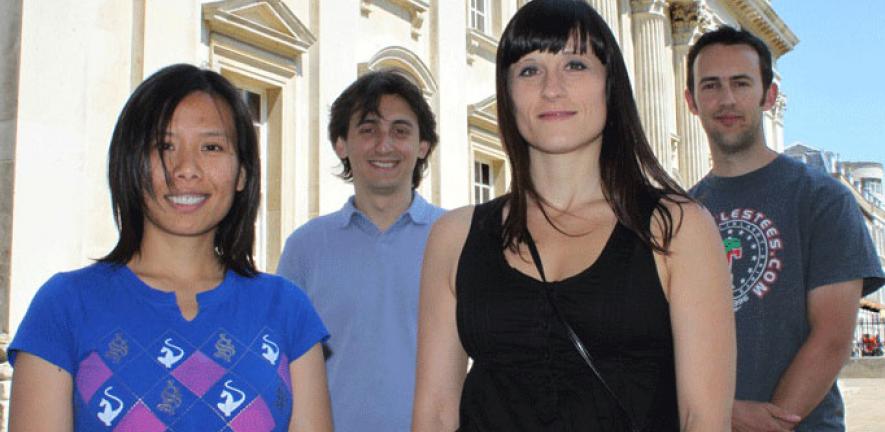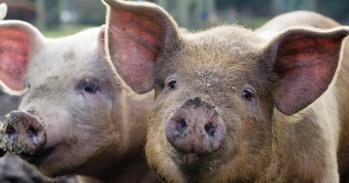
From quantum physics to stem cells: the research of the University's first cohort of Herchel Smith Postdoctoral Research Fellows demonstrates the impact of a legacy.
From quantum physics to stem cells: the research of the University's first cohort of Herchel Smith Postdoctoral Research Fellows demonstrates the impact of a legacy.
The impact of this legacy has been momentous and I have every confidence that its contribution to Cambridge research will continue to gain in importance.
Professor Ian Leslie
On his death in December 2001, Dr Herchel Smith, distinguished organic chemist, Cambridge alumnus and major philanthropist, bequeathed £50 million to the University, representing the largest ever individual bequest to a UK university. The endowment provided enhanced support for the four Professorships he established during his lifetime, as well as five new Professorships, and the Herchel Smith Postdoctoral Fellowship and PhD Studentship programmes.
‘The impact of this legacy has been momentous and I have every confidence that its contribution to Cambridge research will continue to gain in importance,’ says Professor Ian Leslie, Chairman of the Managers for the Herchel Smith Postdoctoral Fellowship Fund. ‘The Herchel Smith Professors provide inspiration and motivation for a whole new generation of talented researchers, while the Postdoctoral and Studentship programmes enable us to attract the best in the world to Cambridge – those with the potential to lead their fields in the future.’
As four of the first cohort of Herchel Smith Research Fellows selected for the postdoctoral programme near completion of their Fellowships, ready to move on to the next stage of their academic careers, we take a look at some of the research that Dr Smith’s legacy has enabled.
Shedding light on quantum matter
Physicist Dr Carlo Sias works in the quantum world of Bose–Einstein Condensates and ultracold ions, an area that is furthering understanding of the fundamental laws of physics as well as paving the way for quantum computers of the future.
His research as part of a team in Dr Michael Köhl’s group in the Department of Physics was published recently in Nature. Combining 12 lasers, precise electronics, magnetic fields, ultra-high vacuum and ‘a bit of luck’, as Dr Sias attests, a four-strong team constructed a new device that could one day be used to cool quantum computers. The machine enables a single trapped ion to be controlled with nanometre precision within a quantum atomic gas cooled to a few billionths of a degree above absolute zero.
By utilising the quantum properties of matter to represent data and perform operations, quantum computers are predicted to outstretch conventional computing in speed, performance and flexibility. Single ions of the type used in Dr Sias’ research hold promise as the basis of quantum computing, and the new machine offers exciting prospects for understanding fundamental physical concepts in quantum simulation. His work will continue in this area following completion of his Herchel Smith Fellowship thanks to his recent successful application for funding from the Leverhulme Trust.
In an adjacent corridor, Dr Yanwen Wu’s research in Professor Richard Phillips’ group is also shedding light on the quantum behaviour of matter. Rather than cold clouds of gas, her work concerns tiny regions of semiconductor known as ‘quantum dots’.
These pieces of material are engineered as part of a process in which the semiconductor is assembled one atomic layer at a time. Quantum dots have practical uses in lasers, but also have properties that make them ideal for testing theories of new types of behaviour, with potential for forms of future device quite different from anything currently in use.
Dr Wu’s interest lies in establishing how electrons within quantum dots behave when excited by laser light energy and how they can be controlled. Recent work has demonstrated for the first time a method for altering the quantum state of the dot in a controlled way. This step, known as inversion by adiabatic rapid passage, is now being extended to collections of quantum dots in order to attempt to achieve a novel collective quantum state. Such experiments represent a small but important move towards some of the future applications of quantum dots.
Tales from the stem cell frontier
Dr Sacri R. Ferron and Dr Tony Southall are each working on neural stem cells – these cell types have the potential to become any cell type within the nervous system, an attribute known as multipotency.
 Dr Ferron’s Fellowship enabled her to join the group of Professor Anne Ferguson-Smith in the Department of Physiology, Development and Neuroscience. The group has been working for many years in the area of epigenetics, the process whereby a further layer of complexity is added to our DNA blueprint in the form of chemical modifications that turn genes on and off. Work in Cambridge and beyond has demonstrated that this DNA ‘decoration’ is inherited, or imprinted, from your parents, and that this can influence processes such as nutrition, growth, cancer and neurological disorders.
Dr Ferron’s Fellowship enabled her to join the group of Professor Anne Ferguson-Smith in the Department of Physiology, Development and Neuroscience. The group has been working for many years in the area of epigenetics, the process whereby a further layer of complexity is added to our DNA blueprint in the form of chemical modifications that turn genes on and off. Work in Cambridge and beyond has demonstrated that this DNA ‘decoration’ is inherited, or imprinted, from your parents, and that this can influence processes such as nutrition, growth, cancer and neurological disorders.
Dr Ferron has uncovered for the first time aspects of the relationship between neural stem cells and their environment in the adult brain, and specifically the phenomenon of ‘reprogramming’ in which stem cells can lose or acquire epigenetic modifications. She has focused on the molecular basis of these changes in stem cell maintenance and her work has important implications for the use of stem cells for therapeutic purposes.
Understanding how stem cells strike a balance between continuous self-renewal and eventual differentiation into one of the many cell types they can become is of fundamental importance both to understanding development and to exploiting the therapeutic potential of stem cells. Dr Southall, across the road at the Wellcome Trust/Cancer Research UK Gurdon Institute, is homing in on its molecular basis.
Working in the laboratory of Professor Andrea Brand, the Herchel Smith Professor of Molecular Biology, Dr Southall has succeeded in identifying the mechanism by which a factor called Prospero (named after the wizard in Shakespeare’s The Tempest), which is expressed in neural stem cells of the fruit fly Drosophila, regulates the switch between self-renewal and differentiation.
In widening the net to identify other components of the stem cell pathway, Dr Southall has built a database (www.neuroblast.org) that is providing researchers worldwide with an entirely new means of identifying important genes. The neuroBLAST program highlights those genes that are bound and regulated not only by Prospero, but also by other stem cell factors. The greater the number of factors that bind to the gene, the more likely it is to have an important role in neural stem cells. Scientists can use this correlation as a signpost to discover previously uncharacterised genes that are active in Drosophila neural stem cells. The hope is that this elegant approach can be applied to other systems in the future.
Herchel Smith Postdoctoral Fellowship Scheme
The aim of the Scheme, which commenced in 2007, is to enable highly motivated, outstanding graduate scholars from any University to come to the University of Cambridge and concentrate solely on their research. Currently there are 25 Research Fellows, selected from institutions worldwide to work in mathematical, physical and life sciences in accordance with Dr Herchel Smith’s particular research interests. The scheme includes a generous stipend and research allowance, which helps Fellows to concentrate on research, travel to conferences and buy additional equipment.
For further information about the Scheme, please contact Mrs Peta Stevens, who is Secretary to the Postgraduate Fellowship Fund (pms1000@cam.ac.uk; Tel. +44 (0) 1223 339093).
This work is licensed under a Creative Commons Licence. If you use this content on your site please link back to this page.





